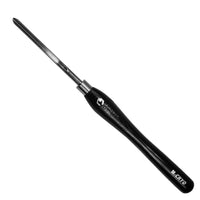
Woodturning is a captivating craft that combines artistry and technique, requiring a variety of specialized tools to achieve the desired results. Among these essential tools, the roughing gouge and spindle gouge are two that often stand out, each playing a crucial role in shaping wood. Although they may seem similar at first glance, their design, functionality, and ideal applications are markedly different. Understanding the distinctions between these two gouges is vital for woodturners looking to refine their skills and improve their craftsmanship.
The roughing gouge is designed primarily for the initial stages of turning, where the primary objective is to remove a significant amount of material quickly and efficiently. Typically characterized by its broad, flat blade and deep flute, the roughing gouge is excellent for transforming square or rectangular blanks into smooth, cylindrical shapes. This tool allows woodturners to work aggressively and rapidly, making it ideal for shaping spindles, legs, and other cylindrical forms. The robust construction of the roughing gouge ensures it can withstand the forces involved in heavy cutting, making it a workhorse in the woodturner's arsenal.
One of the standout features of the roughing gouge is its shallow bevel angle, usually between 20 and 30 degrees. This design facilitates easy penetration into the wood fibers, allowing for efficient material removal. The wide cutting surface enables woodturners to apply significant pressure, making the roughing gouge perfect for quickly shaping larger pieces of wood. However, while this tool excels in bulk material removal, it lacks the finesse needed for intricate detailing, which is where the spindle gouge comes into play.
In contrast, the spindle gouge is specifically crafted for finer, more detailed work. With its narrower profile and elongated blade, the spindle gouge is ideal for creating intricate shapes and curves in spindle work, such as furniture parts, balusters, and decorative items. The flute of a spindle gouge is shallower than that of a roughing gouge, which allows for more precise control and maneuverability. This tool is often used for tasks that require a delicate touch, such as crafting beads, coves, and fillets.
The bevel angle of the spindle gouge is generally steeper, typically around 40 to 45 degrees, which is advantageous for producing clean, smooth cuts. The design of the spindle gouge facilitates a different cutting technique, often employing a slicing or pushing motion. This technique is crucial for achieving the fine details that are characteristic of well-executed spindle work. Unlike the roughing gouge, the spindle gouge is not designed for heavy material removal but excels in refining shapes and adding decorative elements to turned pieces.
The applications for these two tools further illustrate their differences. The roughing gouge is most beneficial during the early phases of turning when a woodturner needs to quickly remove excess material from a blank. It is particularly effective for shaping larger items or reducing the thickness of the wood significantly. However, once the initial rough shape is achieved, a woodturner typically transitions to a spindle gouge for detailing and refining the final piece. The spindle gouge allows for intricate work, ensuring that the details are executed with precision and care.
Using the wrong gouge for a specific task can lead to frustration and suboptimal results. Attempting to use a roughing gouge for delicate spindle work may result in rough edges, uneven surfaces, or even catches that can damage the piece being worked on. Conversely, relying solely on a spindle gouge for initial shaping can lead to inefficiencies and increased effort, as this tool is not built for aggressive material removal. Understanding when and how to use each tool is essential for any woodturner looking to achieve high-quality results.
Moreover, the design and construction of these gouges are tailored to their intended functions. Roughing gouges tend to be heavier and more robust, enabling them to withstand the rigors of aggressive cutting. The flat blade design can create a broad surface area, allowing for quick and effective shaping. On the other hand, spindle gouges are generally lighter and more delicate, making them well-suited for detailed work. Their tapered design facilitates maneuverability, allowing woodturners to navigate tight curves and intricate designs effortlessly.
In the realm of woodturning, mastering the use of different tools is crucial for success. By understanding the unique characteristics and applications of the roughing gouge and spindle gouge, woodturners can select the right tool for each task, improving both efficiency and the overall quality of their work. Embracing the specific strengths of each gouge allows artisans to unlock their creative potential and produce stunning, finely crafted pieces.
Ultimately, the choice between a roughing gouge and a spindle gouge boils down to the specific requirements of the project at hand. Each tool serves its distinct purpose within the woodturning process, and knowing when to utilize each will enable woodturners to achieve their artistic vision while enjoying the rewarding journey that comes with this intricate craft. Understanding these differences will empower woodturners to elevate their skills, enhance their craftsmanship, and bring their creative ideas to life.
